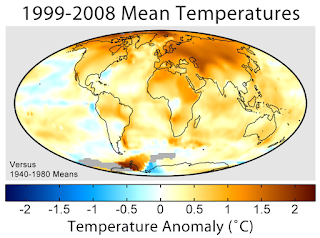The finish of North Pole ice can provoke a new ice age
The paper publicized in Nature “Western Arctic Ocean freshwater storage increased by wind-driven spin-up of the Beaufort Gyre” (Katharine A. Giles, et al. 01/2012), authors talked about a great bulge with 8.000 Km3 of fresh water that is caching between ice and saline water. In the last years its size tends to grow, and the phenomenon is linked to climate change.
The origin of fresh water is the water of the rivers that flow into Artic Sea and snow of ice layer thawed. This water doesn’t blend with the Artic water and its size has a fluctuated seasonal.
The origin of fresh water is the water of the rivers that flow into Artic Sea and snow of ice layer thawed. This water doesn’t blend with the Artic water and its size has a fluctuated seasonal.
Why exits a bulge fresh water and does it blend with Artic water? I can explain it. If you take fresh water and you put into salt, salt dissolves quickly; but if you take fresh and saline water and both put into glass slowly both liquids continue without blended, similar water and oil. This behavior is caused by different density of them also if we stir them water blended. In the sea happens the same but in surface there are wind and waves that remove water and they blend it. The Artic sea is covered by ice and impedes the waves, but there are other cause most significant than it: ocean water is cooler than thaw water and this increments the difference of densities. Fresh water accumulates in a region of Arctic Sea by a circumpolar circulation, this circulation is generated for terrestrial rotation, but Arctic Ocean isn’t a perfect circumference because Greenland and Canada North Island make a wedge. This wedge produces a vortex in a region between Bering and this islands that capture this water and impedes it to go away.
But the global warming rise the thaw and the fresh water accumulated grows. If the bulge has a size greatest than circulation vortex, part of this fresh water cans continue to Atlantic North gate. This thing can be a danger because fresh water captive under ice would get away to Atlantic Ocean. If this would happen the thermohaline circulation can be affected in north hemisphere.
Thermohaline circulation is the vector that is carrying the hot from Ecuador to pols. Where it stops defines limits of warm weather and cold weather. The introduction of fresh water in North Atlantic will lower the limit north of thermohaline. Today the warm weather of Western Europe is derived to where it’s its north end (Norgay north and Baffin Bay) and dominate superficial winds (west), this thing is too easy to see if we compare clime of similar latitudes weather: Lisboa – New York or Turin –Toronto; we can check that how cool is the american weather than european. The change of thermoaline end is cause of beginning and end of the last ice ages, and these changes had sudden.
The hotter weather of last days made a proliferation of papers about the beginning of a new tropical age and the needed that we must stop now to burn fossil fuel. Stop burning fossil fuels we should have done a long time ago, and stop now can help it but it will not stop the change because the change is the consequence of actions that we were beginning more years before. Other thing is what kind of change will arrive us, in this sense sentences of the arrived the hot age because today it’s hotter than never (this affirmation is a silly thing so we have 150 years of temperatures but earth is 4,500 million years old), are opportunistic statements. Now we have some climatic models that more hot means cool weather at finish of process. And one of them is the thermohaline variation.
Today the Arctic Ice has a historic minimum. This is a preoccupant question because part of fresh water is out of its jail and water will be affecting direct by winds, luckily the expected presence of ice in band Canada Islands North Pole blocks the passage of water at North Atlantic Gate, but the next years this band exists again. Too the thaw ice of polar banquice sum in the new fresh water and it will raise the amount of water fresh.
Until today the thaw fresh water remain closed in Arctic sea, but how many years it cans stay in this place. The global warming make summers every years hotter than before so Arctic Banquice will become smaller, and it is possible that will disappear in a near future. The perspective of liberation of fresh water of Arctic and the consequent moving towards the southern end of the thermohaline, cans mean a new ice age.




Comentaris
Publica un comentari a l'entrada